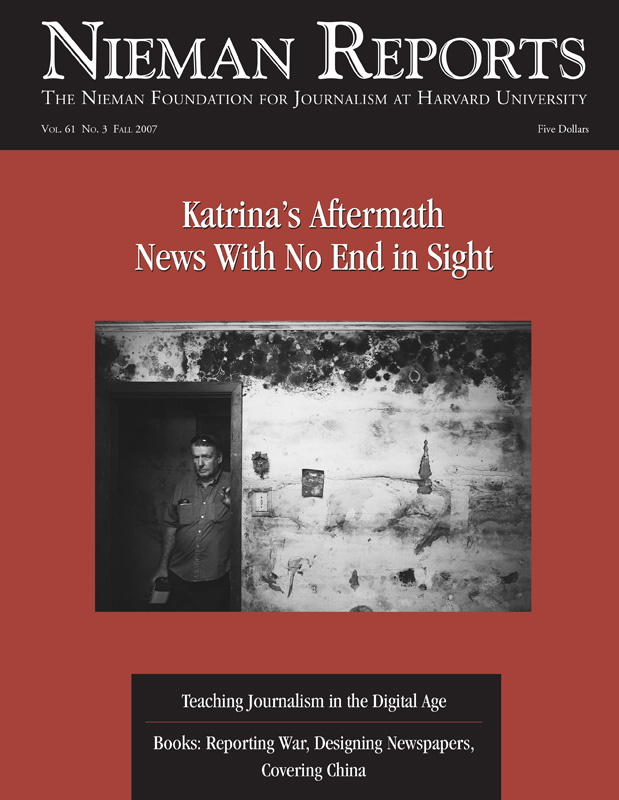The following words are excerpted from an essay written for the September 2007 McCormick Tribune Foundation Conference on the Future of Journalism and Mass Communication Education at Louisiana State University.
Journalism education and the news business have something new in common these days: Each has fallen behind and, in their separate struggles to catch up, each is chasing a moving target. Newspaper companies are learning that playing catch-up is no longer a game of journalistic horticulture; simply grafting the latest trend onto existing business models does not translate into long-term yields. It’s fair to suggest that journalism schools might well avoid the temptation to reach for grafting tools to solve their curriculum problems. They might, instead, head for the plow for a little creative destruction.
In this time of transformation in how news is reported and distributed, the profession and the academy are confronting new media realities in which audiences are empowered to engage with the community’s established news media or bypass it and gather information on their own. There are new questions now, many questions, in fact, and few answers that will tell us what the purpose of journalism is becoming and how journalism schools can prepare students for whatever that might be.
Journalism education seems to go in cycles, following trends, but clinging to basic values. The electronic age has introduced different journalism skills to which students should be introduced, but only introduced; no technician-graduates needed. As faculties ponder new course offerings, the ever-present challenge is how to creatively squeeze more into curricula already limited by the number of hours allowed for majors. In thinking about changes in journalism education that have occurred over more than a generation, it is always reassuring to recognize that one constant remains: the values of journalism. The news of the day is a powerful reminder of how our citizens turn again and again to the press for the stories so vital to understanding the latest crisis.
Whatever changes in course offerings might give graduates a solid understanding of multimedia technology and the skills to report, write and produce online, the true test of academic excellence in journalism would be a curriculum that is sufficiently rigorous in preparing students to report on a society that is increasingly difficult to understand. Journalism schools should invest in their students a spirit of intellectual depth and versatility and a desire for continuous learning over a working lifetime.
Each year, I review more than 100 applications from U.S. journalists who want to study at Harvard as Nieman Fellows. Many of the candidates are journalism school graduates. In their essays, they share their aspirations for the rest of their lives in journalism. The statements are often inspiring as they express an enduring passion for journalism as well as acknowledge that they missed opportunities in college to become better prepared for the complexities of the world they are now covering. There is something revealing in these confessions; journalism school deans might wonder how the apparent shortcomings of a journalism education can become the motivation for midcareer fellowships.
As journalists, we face daily demands to explain, clarify and interpret for our readers, listeners and viewers. The issues we report on, more often than not, contain elements of science and technology, medicine and economics, as well as human emotion and political or ideological conflict. These topics, typically at the core of a Nieman year, also might well be part of a university’s journalism regimen.
As early as 1919, Walter Lippmann, the most influential newspaper columnist of the first half of the last century, recognized that as stories become more and more complex and more specialized, there was a greater need for reporters and editors to master the study of evidence and verification and develop special areas of expertise in which they could do their work in a highly informed and authoritative way.
In a new book, “Five Minds for the Future,” Harvard University psychologist Howard Gardner issues a call for new ways of learning that will prepare students to think globally and function in a world dominated by information, science and technology, and the conflicts among cultures. Gardner’s five minds would master one or more disciplines, would possess capabilities to synthesize information, would be creative, would be respectful, and would work in an ethical manner.
These are values worth considering in the journalism curriculum for the future. They should be part of the larger consideration about how to shape the education of young journalists for the near term and create a new foundation for the longer term. This should not be a discussion of how to graft the latest onto the existing. Tear up the current models that perceive journalism as a craft. Rethink the field as one of rigorous scholarship and practice. And build anew around one truth: journalism matters. Give students that, and they will find their way.



